#House Anjou
Explore tagged Tumblr posts
Text
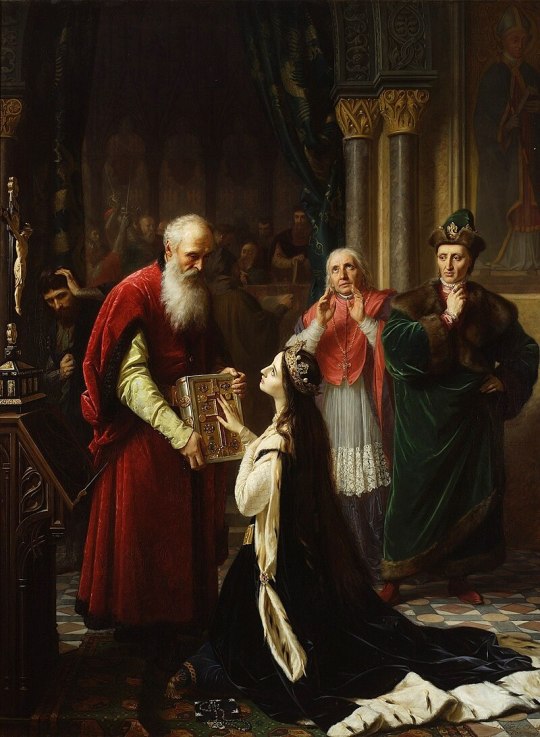
Jadwiga (1373 or 1374 – 17 July 1399), also known as Hedwig, was the first woman to be crowned as monarch of the Kingdom of Poland. She reigned from 16 October 1384 until her death. She was the youngest daughter of Louis the Great, King of Hungary and Poland, and his wife, Elizabeth of Bosnia. Jadwiga was a member of the Capetian House of Anjou, but she had more close forebears among the Polish Piasts than among the Angevins.
In 1375, it was planned that when becoming old enough, she would marry William of Austria and she lived in Vienna from 1378 to 1380. Jadwiga's father is often thought to have regarded her and William as his favoured successors in Hungary after the 1378 death of her eldest sister, Catherine, since the following year the Polish nobility had pledged their homage to Louis' second daughter, Mary, and Mary's fiancé, Sigismund of Luxembourg. However, Louis died, and in 1382, at her mother's insistence, Mary was crowned "King of Hungary". Sigismund of Luxembourg tried to take control of Poland, but the Polish nobility countered that they would be obedient to a daughter of King Louis only if she settled in Poland.
Queen Elizabeth then chose Jadwiga to reign in Poland, but did not send her to Kraków to be crowned. During the interregnum, Siemowit IV, Duke of Masovia, became a candidate for the Polish throne. The nobility of Greater Poland favored him and proposed that he marry Jadwiga. However, Lesser Poland's nobility opposed him, and they persuaded Queen Elizabeth to send Jadwiga to Poland.
Jadwiga was crowned king in Poland's capital, Kraków, on 16 October 1384. Her coronation either reflected the Polish nobility's opposition to her intended husband, William, becoming king without further negotiation, or simply, emphasized her status as the monarch. With her mother's consent, Jadwiga's advisors opened negotiations with Jogaila, Grand Duke of Lithuania, who was still a pagan, concerning his potential marriage to Jadwiga. Jogaila signed the Union of Krewo, pledging to convert to Catholicism and to promote conversion of his pagan subjects. Meanwhile, William hastened to Kraków, hoping to marry his childhood fiancé, Jadwiga, but in late August 1385 the Polish nobles expelled him.
Jogaila, who took the Catholic baptismal name Władysław, married Jadwiga on 15 February 1386. Legend says that she had agreed to marry him only after lengthy prayer, seeking divine inspiration. Jogaila, now styled in Polish as, Władysław Jagiełło, was crowned King of Poland on 4 March 1386 as Jadwiga's co-ruler. Jogaila worked closely with his wife in that role. In any case, her real political power was limited.
She remained passive when the rebellious nobles of the Kingdom of Hungary-Croatia murdered her mother in early 1387. After that, Jadwiga marched into the Kingdom of Galicia–Volhynia, which had been under Hungarian rule, and persuaded most of the inhabitants to become subjects of the Polish Crown. She mediated between her husband's quarreling kin and between Poland and the Teutonic Order.
After her sister Mary died in 1395, Jadwiga and Jogaila laid claim to Hungary against the widowed Sigismund of Luxembourg, but the Hungarian lords did not support their claim and Sigismund easily retained his Hungarian throne. Jadwiga died four years later due to postpartum complications.
In 1997, Jadwiga was canonized by the Catholic Church.
2 notes
·
View notes
Text

Elizabeth of York, fashion character design, c. 1481.
#the wars of the roses#15th century#historical#medieval#british history#medieval england#art#illustration#sketch#edward iv#elizabeth woodville#elizabeth of york#henry vii#henry vi#margaret of anjou#margaret beaufort#isabel neville#richard iii#the white queen#the white princess#medieval fashion#historical fashion#character design#artists on tumblr#medieval costume#royals#house of york#plantagenets
475 notes
·
View notes
Text

Felipe V of Spain (!!)
#sketch#doodle#17th century#bourbon anjou#house of bourbon#spanish monarchy#philip v of spain#digital art#historical art#historical figures#him being judgy k#kinda#artists on tumblr#royal history#18th century
57 notes
·
View notes
Text
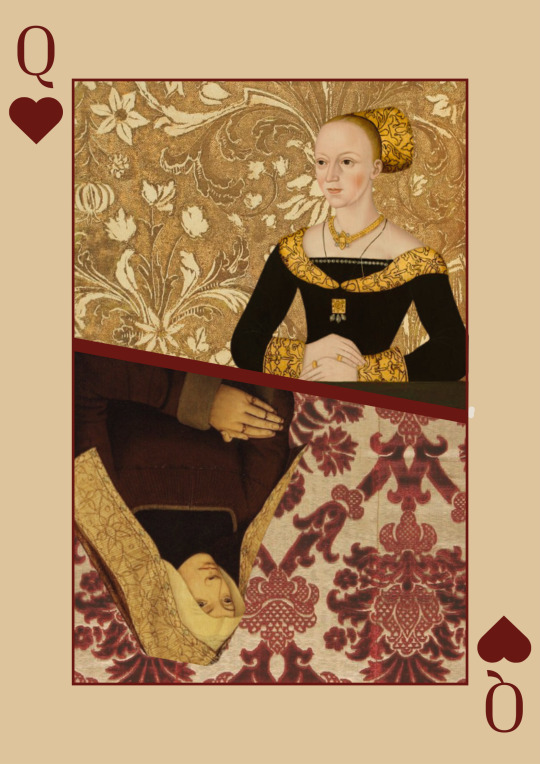
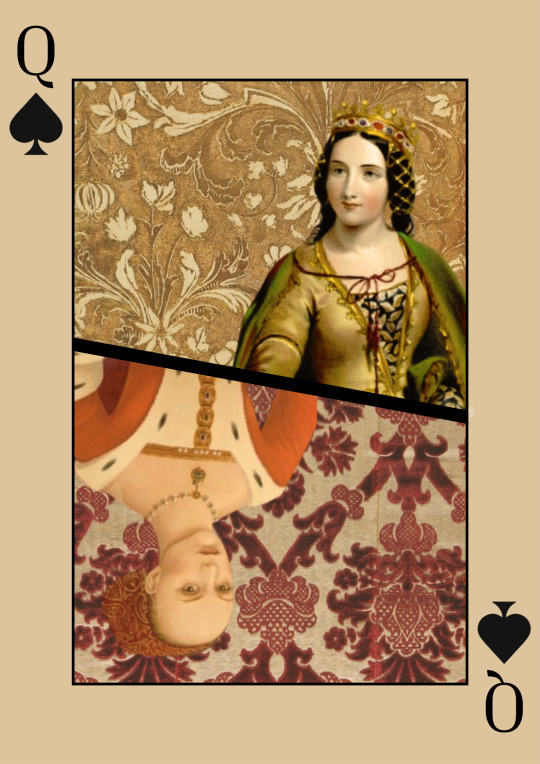
|| 𝐄𝐥𝐢𝐳𝐚𝐛𝐞𝐭𝐡 𝐖𝐨𝐨𝐝𝐯𝐢𝐥𝐥𝐞 & 𝐌𝐚𝐫𝐠𝐚𝐫𝐞𝐭 𝐁𝐞𝐚𝐮𝐟𝐨𝐫𝐭 ||
|| 𝐀𝐧𝐧𝐞 𝐍𝐞𝐯𝐢𝐥𝐥𝐞 & 𝐌𝐚𝐫𝐠𝐚𝐫𝐞𝐭 𝐨𝐟 𝐀𝐧𝐣𝐨𝐮 ||
#elizabeth woodville#margaret beaufort#anne neville#margaret of anjou#wars of the roses#house york#house lancaster#historyedit
145 notes
·
View notes
Text
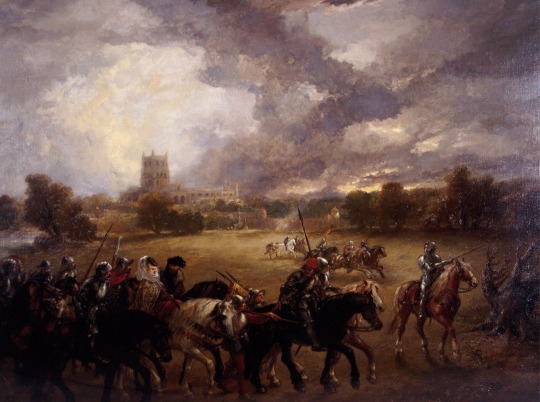
Margaret of Anjou Taken Prisoner after the Battle of Tewkesbury by John Gilbert
#battle of tewkesbury#wars of the roses#margaret of anjou#art#john gilbert#england#medieval#middle ages#tewkesbury abbey#house of york#house of lancaster#english#history#gloucestershire#europe#european#mediaeval#knights#knight#soldiers#palfrey#horses#sky#landscape#clouds#edward iv#edward of westminster#sir john gilbert
111 notes
·
View notes
Text
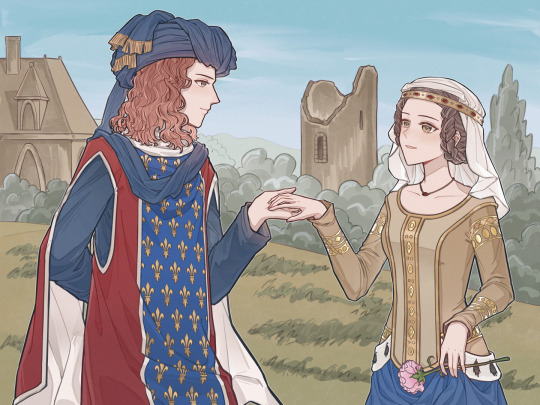
Thanks @hilda-dewitt for this great piece of work depicting Louis I of Anjou and Marie of Blois, great-grandparents of Margaret of Anjou. Louis I of Anjou was the founder of the Angevin cadet branch of the House of Valois, and Marie of Blois was the first of a series of powerful women in the House of Valois-Anjou.
I really found their story to be full of fun and drama. After King John II of France was taken prisoner in the Battle of Poitiers, Louis broke the Aragonese marriage contract arranged by his father to marry Marie, the daughter of one major claimant to the ducal throne of Brittany, neighboring his appanage of Anjou. His desire to meet his wife pushed him to end his hostage career in England prematurely on his own, and more or less led to the decision of John II to return to captivity, lol. While Marie's father fell in battle six months after John the Good's death in London, the couple remained close and intimate throughout their lives. Louis served as a leading military commander in his elder brother Charles V's reconquest of southwestern France during the second phase of the Hundred Years' War. He was also a loyal friend and protector of Bertrand du Guesclin, who fought for Marie's father before entering service for the Valois. However, due to his role in the 1378 tax revolts and his overambitious claim to the throne of Naples, Louis remained a controversial figure in France, and his past accomplishments were little appreciated. After Louis's death in the unsuccessful march to Naples, Marie continued their quest for the Neapolitan crown, and, after a tough fight against opposing claimants, secured for their seven-year-old son Louis II the County of Provence, which was in a personal union with the Kingdom of Naples. She acted as regent for Louis II during his minority, and arranged the marriage between him and Yolande of Aragon.
#Louis I of Anjou#Marie of Blois#hundred years war#medieval#fanart#historical fanart#french history#commission art#house of valois#margaret of anjou#Yolande of aragon
60 notes
·
View notes
Text
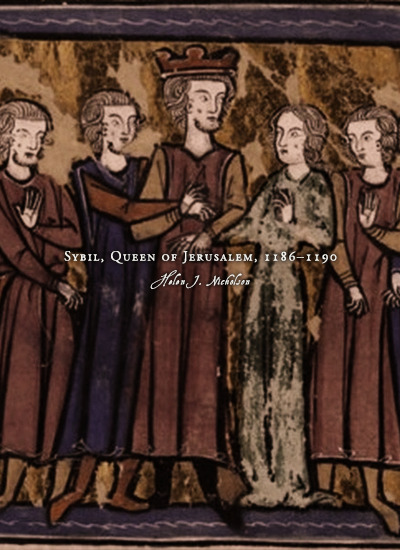

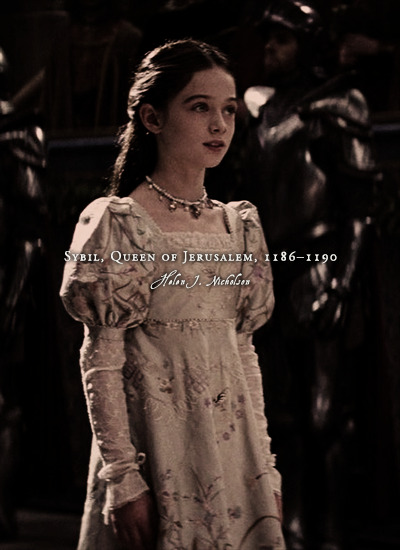
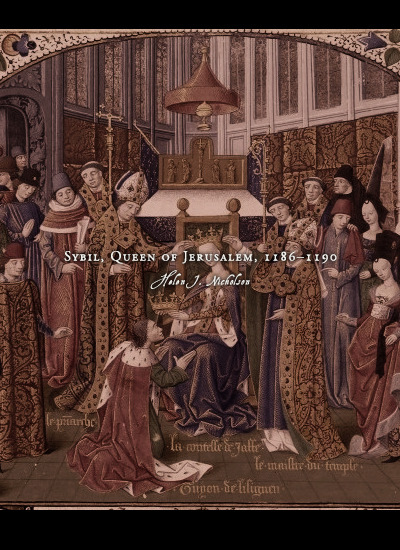


Favorite History Books || Sybil, Queen of Jerusalem, 1186–1190 by Helen J. Nicholson ★★★★☆
As a child, Sybil’s future prospects appeared excellent: as the eldest child of King Amaury of Jerusalem and as a member of the dynasty that claimed descent from Godfrey de Bouillon and the other heroes of the First Crusade, we might expect that she would have been an attractive marriage prospect. Yet European noblemen did not queue up to seek her hand. One reason for this might have been that commanding the defence of the kingdom of Jerusalem in the face of aggressive Muslim expansionism was a daunting prospect for any warrior, no matter how ambitious. Moreover, as her brother Baldwin’s illness became generally known in Europe, Sybil’s potential husbands may have wondered whether she and her children would be similarly afflicted. In addition, as her brother Baldwin and his council made clear to Philip of Alsace in autumn 1177, outside aid was unwelcome in the kingdom except on the terms they dictated. Robert VI of Béthune, Philip of Alsace’s candidate for Sybil’s hand, might have made a more effective count of Jaffa and Ascalon, regent of the kingdom and king consort than Guy de Lusignan, but Baldwin – aged only sixteen at the time of Count Philip’s crusade – preferred to marry his sister to a man he knew. If King Baldwin IV had supported his elder sister as the heir who – given that Baldwin V was very young and in uncertain health – would almost certainly inherit the kingdom, it might have been possible for Sybil to unite the nobles of the kingdom behind her as her brother had done. But his contradictory and changing policies left her rights of inheritance unclear and the nobles of the kingdom divided. He married her to one of his household knights, then attempted to divorce them; he appointed her husband as procurator, then shortly afterwards deposed him and appointed her son as his co- ruler, and then appointed another procurator, then finally appointed two regents, one to care for the young king Baldwin V and the other to govern. If he made further arrangements for the succession after Baldwin V they were unworkable. By marrying his younger half-sister to a leading noble of the kingdom but forcing the bridegroom to surrender his inherited estates in return, King Baldwin IV ensured that both his sisters and their husbands and supporters had grievances against him. While his measures reduced any threat that he would be overthrown during his lifetime, they boded badly for the kingdom after the death of his immediate heir. Given the rivalries between the leading nobles of the kingdom and Saladin’s need to win a decisive victory over the Franks, no one could have prevented Saladin from taking Jerusalem and conquering most of Sybil’s kingdom; Sybil was doomed to failure as queen. Not only did she lose Jerusalem, but she also failed in the most fundamental function of a noblewoman: she failed to provide an heir for herself, as both her son Baldwin and her daughters died in childhood. On the other hand, in the face of disaster she did not abandon her kingdom and flee to Europe, nor did she retire to a religious house. Instead, she stayed in the crusader states and did all she could to oppose the invader. She tried to defend Ascalon, she remained in Jerusalem until it was surrendered to Saladin, she obtained her husband’s release from Saladin’s prison, and by accompanying him in the months that followed she gave him the authority to continue as king of Jerusalem. As husband of the eldest daughter of King Amaury of Jerusalem and as a crowned king, Guy had a stronger claim to royal authority than Conrad of Montferrat: crusaders from Europe rallied to him and the representatives of the Italian maritime cities supported him so that he could begin the fightback against Saladin which was continued by the Third Crusade and enabled the kingdom of Jerusalem to continue to exist until 1291. When Sybil died, Guy’s authority died with her; but she had ensured that her kingdom would not die, at least for another century.
#historyedit#litedit#sibylla of jerusalem#french history#medieval#asian history#european history#women's history#history#house of anjou#history books
70 notes
·
View notes
Text

Marguerite d'Anjou, Reine d'Angleterre (1430-1482).
#kingdom of england#margaret of anjou#queen consort#queen of england#house of lancaster#house of anjou#wars of the roses#royaume d'angleterre#maison d'anjou#maison de valois#full-length portrait#full length portrait#royalty
27 notes
·
View notes
Text
"The variety of accusations with Margaret [of Anjou] reveals the complexity of fifteenth-century anxieties about queenship and queenly authority. There was concern about dependence upon a foreign woman for a much needed heir to guarantee stability, fear of her potential to foster false heirs, fear of her potential to abuse her proximity to the king by drawing others close to the king at the expense of those who should have been his councilors, and fear of the potential for chaos and the subversion of right order in any daughter of Eve."
joanna laynesmith, "telling tales of adulterous queens in medieval england: from olympias of macedonia to elizabeth woodville."
#margaret of anjou#henry vi#wars of the roses#history#house of lancaster#house of york#women's history#royal history#english history#french history#medieval era#medieval history#middle ages#*quotes
40 notes
·
View notes
Text
As Chesterton said somewhere, one obvious moral superiority of medieval to either modern or ancient society, is that in the joust, the rich people beat the shit out of each other as an entertainment, rather than paying poor people (or keeping slaves) to get beat up for them. (Okay the high salaries of pro sports muddy this, of course, but those are people of poor background, whereas the team owners are from the business elite. In medieval Europe you’d see Clark Hunt and Rob Walton out on the gridiron getting traumatic brain injury.)
#salty amateur historian#of course it WAS probably a jousting head-injury that made henry viii bad even by angevin standards#(tudors are plantagenets are a branch of the house of anjou)
41 notes
·
View notes
Note
What do you feel about the house of york
I feel like it's a medieval dynasty that one a war. That's about it.
I also think that Richard Duke of York was nothing more than a jealous cousin that saw the perfect opportunity to climb the ladder and took it, justly paying the price. Edward IV's anger over his and his brother's death is understandable and so were his actions. Too bad that he didn't saw that the Duke of York's ruthless ambitions had trickled down to his sons Richard and George before they tried it with him. I think the Woodvilles were overtly greedy and took too much of the hand that fed them making the nobility hate them, and they also paid for it. I mean, arranging prestige marriages for every single Woodville? I get it, one of them was the Queen, but come on now, they clearly overplayed.
On the whole, I find this representation of the Yorks as this typical Good HeirsTM that took their rightful place on the throne and stepped up through harsh times that persists so much to this day lame and reductive. The truth of the matter is, they were never more just and GoodTM than the Lancasters. The Lancasters successfully organized a coup and sat the throne, the Yorks did the same, demonizing Henry VI and Queen Margaret of Anjou through propaganda as a freak and an overly ambitious femme fatale respectively, while casting their teenage son as a cruel bastard. All for defending fiercely what was by right theirs (we have Shakespeare to blame for that as well).
#wars of the roses#house york#house lancaster#edward iv#richard duke of york#george plantagenet#richard iii#Henry vi#margaret of anjou#edward of westminster#medieval warfare#medieval england#late middle ages
42 notes
·
View notes
Text

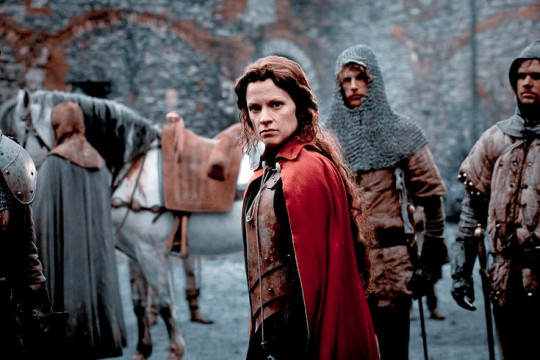



the white queen 10 year anniversary: best queen - m a r g a r e t | o f | a n j o u
#margaret of anjou#the white queen#twq#twqedit#twq10#perioddramaedit#15th century#wars of the roses#house of lancaster#weloveperioddrama#myedit*#mine*
48 notes
·
View notes
Text
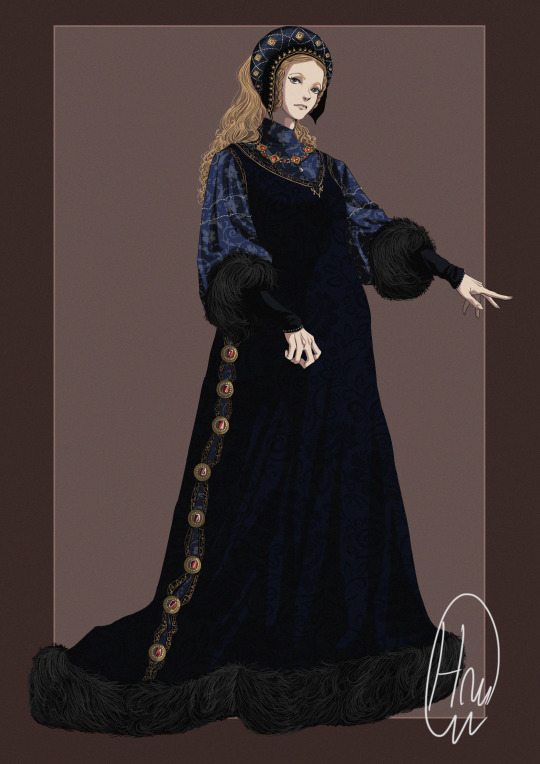
Elizabeth of York, fashion character design. Mourning outfit, c. 1482.
#the wars of the roses#15th century#medieval#middle ages#historical#british history#medieval england#art#illustration#sketch#edward iv#elizabeth woodville#elizabeth of york#henry vii#henry vi#margaret of anjou#margaret beaufort#isabel neville#richard iii#the white queen#the white princess#medieval fashion#historical fashion#character design#artists on tumblr#medieval costume#royals#house of york#plantagenets
448 notes
·
View notes
Note
Are you Lancaster
1) This is indeed @whiteswanoflancaster — I just have a very strange blogging setup going on that I haven’t bothered to do anything about yet😭
2) a little self-consciously, but yeah! I find it rather strange to take sides in a 550–year–old conflict, but despite that I’d say I support the Lancastrians! This is because:
- While Richard of York was undoubtedly more competent than Henry VI — and while I’d even argue he didn’t want to take the crown — there’s no getting around either the fact that he did or the fact that, in doing so, he completely destabilised the system of government in England, which probably wasn’t a price worth paying — many historians argue that Edward IV and Henry VII introduced a “new monarchy,” their financial systems and tight control of the nobility actually resembled the systems of earlier rulers such as Edward III, and weren’t all that new at all! There isn’t really a huge difference between Edward IV giving land to his brothers and Edward III giving it to his sons, in my opinion — and so the Wars of the Roses and by extension York’s decision to disrupt the system by claiming the crown led to politics taking a bit of a “backward step” towards a less efficient system. Without that disruption, England might have been better able to flourish in the sixteenth century — and there’d have been far less death.
- Their story is just appealing in my opinion! There’s a certain romance to it that caught my attention and refused to let go — and it’s also there at the end of the wars, with Henry Tudor and his allies standing for Lancaster. It’s a little bit shallow, but I do love a good story — and this is certainly that!
- Margaret of Anjou was very, very cool and deserves to be more widely known about and appreciated. Enough said 😭
#wars of the roses#history#fifteenth century#house of lancaster#there are two wolves inside me#the serious historian#and the Margaret of Anjou fangirl#ask#thanks for the ask!
13 notes
·
View notes
Text
we did a school exchange programme with a high school in the Pays Loire in TY (back in 2015) and we visited l'Abbayé de Fontevraud ... I was literally mad excited to see Henry and Eleanor and Richard (together ... <3) ... and Isabella of Angoulême is there as well <3 ugh
#house of Plantagenet-Angevin ...#Angevin just means 'of Anjou' isn't that so pretty?#I love that medieval-flavoured French
2 notes
·
View notes
Text

Haute-Brise manor house in Segré, Anjou region of France
French vintage postcard
#briefkaart#haute#photography#vintage#tarjeta#postkaart#french#postal#segr#photo#brise#postcard#historic#carte postale#anjou#region#ephemera#manor#sepia#france#ansichtskarte#postkarte#house#segré
2 notes
·
View notes